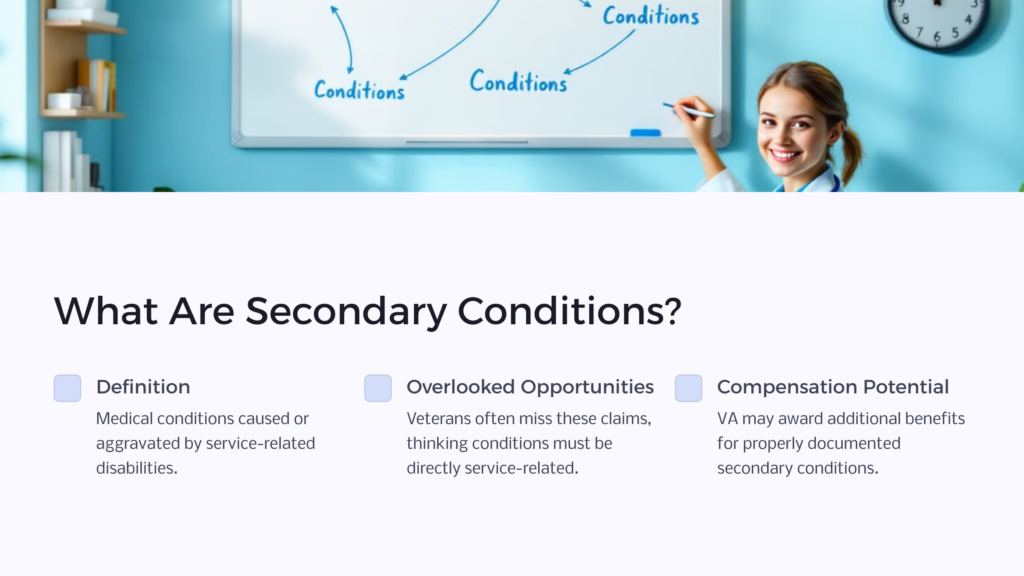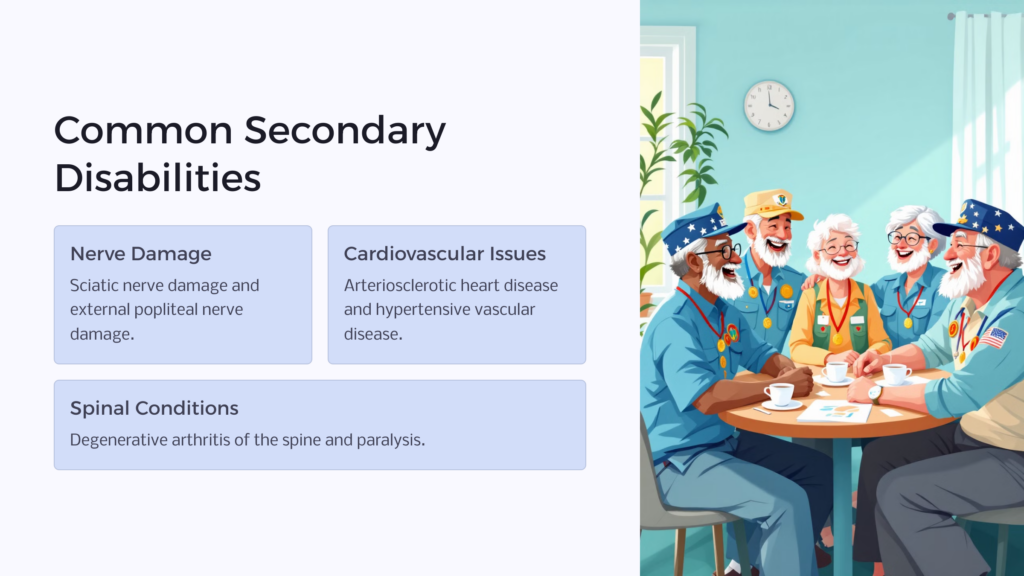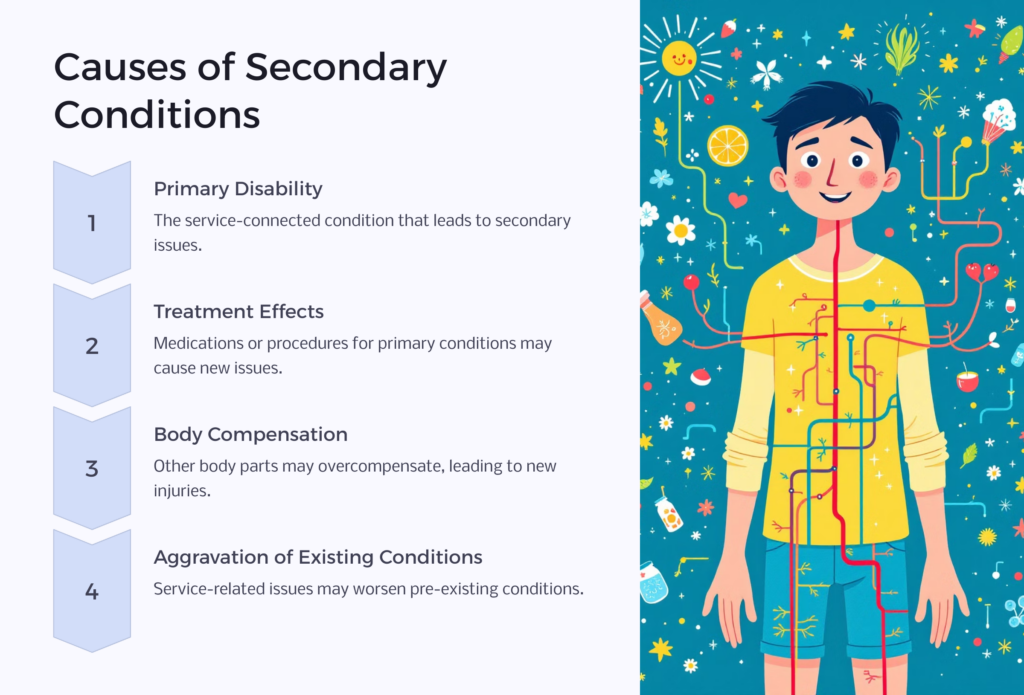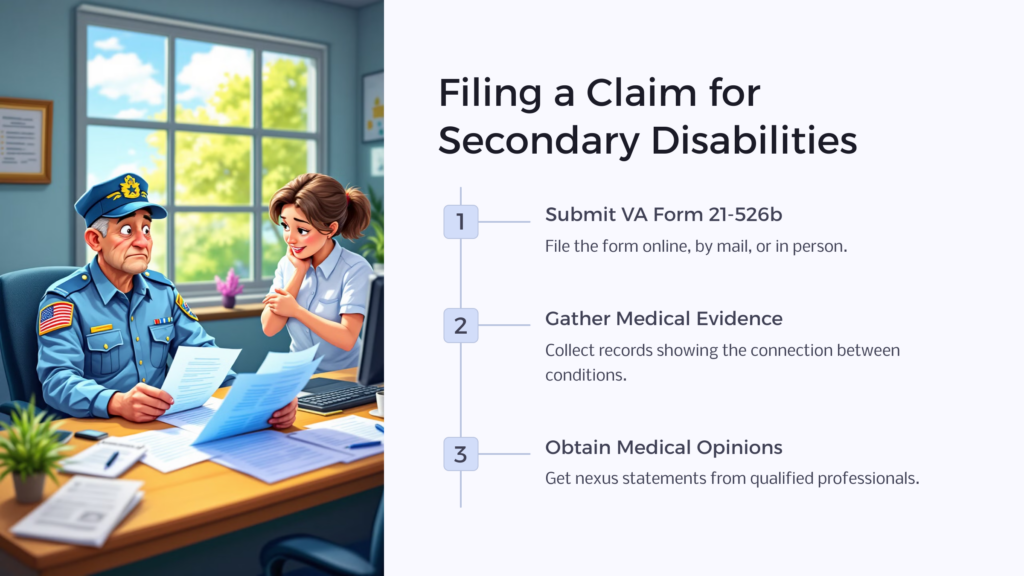While most veterans are familiar with the VA disability benefits program, there often is a misconception that VA disability compensation is limited to active duty, service-connected medical conditions – and this simply isn’t true. In many cases, those who suffer from a primary disability also may deal with secondary illnesses, conditions, or injuries that are either directly caused by or further exacerbated by that primary disability.
These conditions are known as secondary disabilities, and they sometimes may mean you’re eligible for additional veterans disability benefits if the medical connection is strong enough and effectively documented.
10 Common Secondary Disabilities
- Sciatic nerve damage
- Erectile dysfunction
- Paralysis
- Arteriosclerotic heart disease
- Arteriosclerosis obliterans
- Hypertensive vascular disease
- Renal involvement in systemic diseases
- External popliteal nerve damage
- Neuritis
- Degenerative arthritis of the spine
It’s no secret that many medical conditions are related. The human body’s systems depend on inter-relationships. Connected conditions can have a causal relationship, and some conditions can aggravate or intensify the symptoms of others.
A service-connected disability can be a profound effect on a person’s ability to carry out day-to-day activities, including work-related functions. When these medical connections lead to severe outcomes for disabled veterans, and when the secondary service connection can be appropriately and effectively documented, it may be possible to successfully claim these secondary conditions within a VA disability benefits claim.
What Is a Secondary Condition?

When discussing VA disability benefits, a secondary condition is a medical illness, condition, or injury that is either directly caused by or aggravated by a service-related disability. While secondary conditions were not directly caused by military service, the VA often will award additional benefits related to them because they are medically related to the original service injury.
It’s common for veterans to overlook secondary disabilities since they were not directly caused by their time of service. This may lead a disabled veteran to think that nothing can be done to compensate for the new health condition. But if a service-connected condition directly led to or intensified an additional medical condition, that creates a connection, or a nexus, between the two and the VA may compensate you.
Sometimes, for example, a secondary disability may develop as a result of the treatment given for the service-related condition. This is common as a result of medications that may affect the functioning of the liver, kidneys, or stomach. In other cases, a secondary disability may be the result of a surgical procedure, or even as a natural consequence of the service-connected condition. For example, neuropathy that develops from the presence of service-connected diabetes. In addition, many veterans deal with mental health issues like PTSD, anxiety, or depression, which may lead to other conditions such as sleep apnea or migraines.
For some veterans, a primary service-related injury or condition may lead other parts of the body to overcompensate, which also can lead to injury or secondary conditions. And for others, pre-existing, non-service-related conditions, like lower back pain, for example, can be aggravated or intensified by the service-related condition. In this case, a knee injury sustained during military service could irritate an existing lower back condition.
When the VA determines that a secondary condition is irritated by a service-connected condition, that means that the service-connected disability caused the secondary condition to progress at a faster or more severe rate than would normally be expected for that condition.
10 Common Secondary Disabilities

Let’s take a closer look at some common secondary disabilities that may be included in a VA disability secondary claim.
Sciatic Nerve Damage
This type of nerve damage often occurs when a narrowing of the spine, a herniated disc, or even a spinal bone spur compresses the sciatic nerve, which runs from the lower back, through the hips and buttocks to the upper thighs. The result is usually chronic pain and numbness in the affected area. The typical health care approach for sciatic nerve damage is non-surgical, though some patients with severe cases that affect mobility may be candidates for surgery.
Erectile Dysfunction
Many military veterans suffer erectile dysfunction, or the inability to sustain an erection during sexual intercourse. ED often is tied to other underlying health conditions, including post-traumatic stress disorder and depression. In many cases, treatment of the underlying condition often also treats the erectile dysfunction issue.
Paralysis
Paralysis occurs when a patient loses control over a muscle or muscle group. This usually happens when there is an interruption within the nerve cells that deliver messages between the brain and the body’s muscles and is not typically an issue with the muscles themselves.
Paralysis can occur as a secondary result of a wide variety of illnesses and injuries, and can be partial or total, temporary, or permanent. Depending on the type and severity of paralysis, treatment may include physical and/or occupational therapy, mobility and support aids, and assistive technologies or equipment.
Arteriosclerotic Heart Disease
This kind of heart disease occurs when the blood vessels charged with carrying nutrients and oxygen throughout your body become thick and stiff, which restricts blood flow. The condition may be treated with surgery, medication, lifestyle changes like diet and exercise, or some combination of the three.
Arteriosclerosis Obliterans
This type of arterial disease usually affects the abdominal area, plus the small and medium-sized arteries of the lower extremities. Symptoms include numbness and discomfort, and in the worst cases can lead to gangrene or the development of ulcers. While there is no definitive health care treatment for arteriosclerosis obliterans, it can often be successfully managed with medication.
Hypertensive Vascular Disease
This condition refers to any heart issue caused by high blood pressure. Illnesses include the thickening of the heart muscle, heart failure, narrowing of the arteries, and coronary artery disease, among others. Its trademark symptoms include pain in the neck, back, arms, or shoulders, shortness of breath, chest pain, and leg or ankle swelling.
Renal Involvement in Systemic Diseases
Several different chronic diseases affect the kidneys, such as congestive heart failure, HIV, diabetic nephropathy, liver disease, dysproteinemias, and lupus nephritis.
External Popliteal Nerve Damage
This condition is highly correlated with sciatica and often occurs after suffering some sort of trauma to the head, neck, or spine, and in more rare cases may be the result of tumors that compress the external popliteal nerve. This type of damage can be treated with everything from physical therapy to surgery.
Neuritis
Neuritis can be inflammation of a particular nerve or general inflammation of the entire nervous system. It’s typically caused by autoimmune diseases, injuries, or infections and is often seen in combination with sciatica. Its symptoms include pain, numbness, or a “pins-and-needles” feeling in the affected area. Neuritis often is treated by addressing the root cause of the inflammation, along with various efforts to control the symptoms.
Degenerative Arthritis of the Spine
Also known as noninflammatory arthritis, degenerative arthritis of the spine is the most common form of spinal arthritis, typically caused by the cartilage between vertebrae wearing down over time, due to wear and tear and/or autoimmune triggers. Back or spinal cord injury also may contribute to a person’s chances of developing degenerative arthritis of the spine. This condition typically affects the lower back and is most painful when a person bends or twists the spine. This type of arthritis is generally treated with physical therapy, corticosteroids, nonsteroidal anti-inflammatory drugs, and in some cases, surgery.

How Do I Get Benefits for a Secondary Disability?
The process for filing a claim for a secondary disability is fairly simple. VA Form 21-526b is what you need to complete and submit to the VA. You can mail it in, drop it off in person of complete and submit it online. However, being approved for a secondary service-connected disability claim is much more involved than simply submitting this form.
As with most things related to your VA disability claim, your chances for success hinge on the quality and detail of your medical evidence. Your claim needs to show a clear nexus – or connection – between your service-related disability and your secondary disability. You will need to provide all appropriate medical records for the existence and severity of your secondary condition before the service-related issue. Medical evidence must show how your secondary disability changed following the service-related injury or illness.

You must have a diagnosis of the secondary condition. The VA will not recognize a secondary condition based merely on symptoms. There must be an official medical determination by a physician.

It’s often helpful to have the opinion of multiple qualified medical professionals, stating that the two conditions have a relationship. This type of opinion typically is submitted as a nexus statement, which will cite sound medical research and present data from medical journal studies that support a causal relationship between your two diagnosed conditions. The nexus statement may cite previous BVA cases that have established precedence for the two conditions in question to be medically linked and veterans compensated accordingly.
For your claim to be successful, a VA medical examiner must then determine from what’s presented in your documentation that the severity of your secondary disability is due to your service-related disability. In other words, medical evidence must clearly show the following:
- The current severity level of the secondary disability
- A professional medical opinion around whether the disability with a service connection caused the secondary disability either to appear or to increase in severity
- All medical considerations and evidence supporting this assertion
Because secondary disability claims can get complicated, this is an area where it may make sense to work with a trusted and knowledgeable disability attorney or a Veterans Service Officer. Either or both can help you determine the strength of your VA claim for a secondary disability, along with collecting the necessary and most compelling medical evidence possible.
VA Benefits for Secondary Disabilities
It’s not uncommon for a disabled veteran to suffer multiple conditions that stem from the same initial injury or service-connected disability. Secondary conditions also merit a VA disability rating – which translates into additional VA benefits for the disabled veteran.
However, many veterans often overlook secondary disabilities or conditions when they make their initial disability benefit claims. Make sure you’re not one of those veterans. If you have reason to believe that you have secondary conditions related to your service-related disability, it’s important to pursue the appropriate medical evidence and submit it to the VA.
 Benefits.com Advisors
Benefits.com Advisors
With expertise spanning local, state, and federal benefit programs, our team is dedicated to guiding individuals towards the perfect program tailored to their unique circumstances.
Rise to the top with Peak Benefits!
Join our Peak Benefits Newsletter for the latest news, resources, and offers on all things government benefits.


















